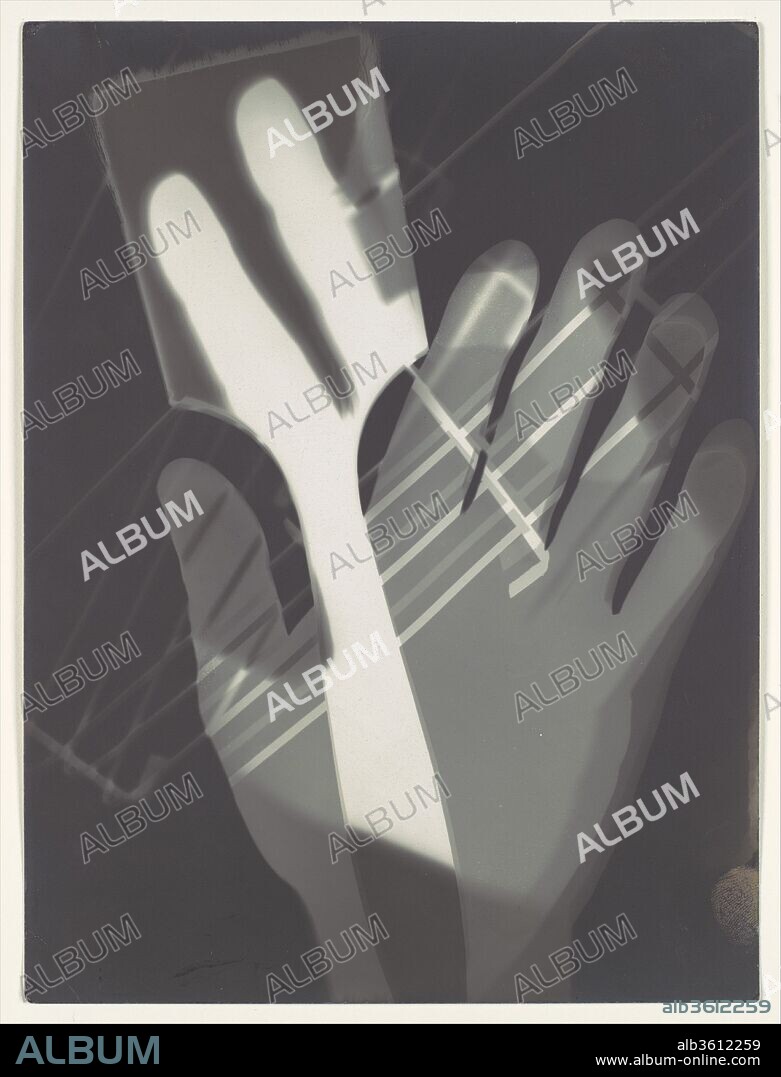alb3612259
LÁSZLÓ MOHOLY-NAGY. Fotogramm

|
Añadir a otro lightbox |
|
Añadir a otro lightbox |



¿Ya tienes cuenta? Iniciar sesión
¿No tienes cuenta? Regístrate
Compra esta imagen

Título:
Fotogramm
Descripción:
Traducción automática: Fotograma. Artista: László Moholy-Nagy (American (nacido en Hungría), Borsod 1895-1946 Chicago, Illinois). Dimensiones: 23,9 x 17,9 cm (9 7/16 x 7 1/16 pulg.). Fecha: 1926. Moholy-Nagy desempeñó un papel clave en la Bauhaus de Weimar y Dessau como pintor, artista gráfico, profesor y apasionado defensor de la fotografía de vanguardia. Hizo esta imagen sin cámara colocando objetos ordinarios, incluyendo su mano y un pincel, sobre una hoja de papel fotosensibilizado y exponiéndolos a la luz. Si bien este sencillo proceso fue practicado por los fundadores de la fotografía en el siglo XIX y más tarde se popularizó como diversión infantil, los artistas de vanguardia del siglo XX revivieron la técnica del fotograma como un medio para explorar las propiedades ópticas y expresivas de la luz. Con esta imagen sombreada de una mano y un pincel, Moholy-Nagy sugiere ambiciosamente que la fotografía puede incorporar, e incluso trascender, la pintura como el medio más importante de expresión artística en la era moderna.
Fotogramm. Artist: László Moholy-Nagy (American (born Hungary), Borsod 1895-1946 Chicago, Illinois). Dimensions: 23.9 x 17.9 cm (9 7/16 x 7 1/16 in.). Date: 1926.
Moholy-Nagy played a key role at the Bauhaus in Weimar and Dessau as a painter, graphic artist, teacher, and impassioned advocate of avant-garde photography. He made this image without a camera by placing ordinary objects, including his hand and a paintbrush, on a sheet of photosensitized paper and exposing it to light. While this simple process was practiced by photography's founders in the nineteenth century and was later popularized as a child's amusement, avant-garde artists in the twentieth century revived the photogram technique as a means for exploring the optical and expressive properties of light. With this shadow-image of a hand and paintbrush, Moholy-Nagy ambitiously suggests that photography may incorporate, and even transcend, painting as the most vital medium of artistic expression in the modern age.
Reportaje:
Técnica/material:
Gelatin silver print
Museo:
Metropolitan Museum of Art, New York, USA
Crédito:
Album / Metropolitan Museum of Art, NY
Copyright:
© Laszlo Moholy-nagy, VEGAP.
Los derechos de autor del artista deben liquidarse si la obra no está en dominio público en el país para el que se contrata la licencia.
Para la explotación de las imágenes de los autores cuyos Derechos gestiona Visual Entidad de Gestión de Artistas Plásticos (VEGAP) es necesario obtener su autorización, la cual está sometida al pago de las tarifas generales.
Los derechos de autor del artista deben liquidarse si la obra no está en dominio público en el país para el que se contrata la licencia.
Para la explotación de las imágenes de los autores cuyos Derechos gestiona Visual Entidad de Gestión de Artistas Plásticos (VEGAP) es necesario obtener su autorización, la cual está sometida al pago de las tarifas generales.
Autorizaciones:
Modelo: No - Propiedad: No
¿Preguntas relacionadas con los derechos?
¿Preguntas relacionadas con los derechos?
Tamaño imagen:
3204 x 4202 px | 38.5 MB
Tamaño impresión:
27.1 x 35.6 cm | 10.7 x 14.0 in (300 dpi)
Palabras clave:
 Pinterest
Pinterest Twitter
Twitter Facebook
Facebook Copiar enlace
Copiar enlace Email
Email
